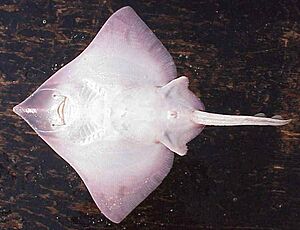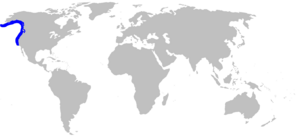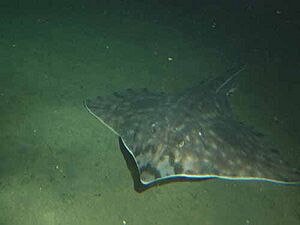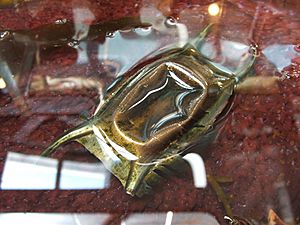Big skate facts for kids
Quick facts for kids Big skate |
|
|---|---|
 |
|
 |
|
| Conservation status | |
| Scientific classification | |
 |
|
| Range of the big skate | |
| Synonyms | |
|
The big skate (Beringraja binoculata) is the biggest type of skate found near North America. You can find them along the Pacific Coast, from Alaska all the way down to Baja California. They usually live in shallow waters, from the beach area down to about 120 meters (390 feet) deep. Big skates eat small animals that live on the seafloor, like bottom-dwelling invertebrates, and tiny fishes. What's special about them is that their egg cases can hold up to seven eggs! Big skates are also caught for food, especially off the coast of California.
Contents
Understanding the Big Skate's Name
A scientist named Charles Frédéric Girard first described the big skate in 1855. Its scientific name, binoculata, comes from two Latin words. "Bi" means "two," and "oculatus" means "eyed." This name refers to the two large, dark spots on its "wings" (pectoral fins) that look like eyes.
For a while, this skate was known as Raja binoculata. But in 2012, scientists moved it to a new group called Beringraja. This new group also includes the mottled skate (B. pulchra).
Where Big Skates Live
Big skates live in the north-eastern Pacific Ocean. Their home stretches from the eastern Bering Sea and the Aleutian Islands down to Cedros Island off central Baja California. They are not often seen south of Point Conception, California.
You can find them in coastal bays, estuaries, and over the continental shelf. They usually prefer sandy or muddy bottoms. While they have been found as deep as 800 meters (2,600 feet), they usually stay in waters no deeper than 120 meters (390 feet). In the northern parts of their range, they tend to live in even shallower water. They are very common off British Columbia, where they like depths of 26–33 meters (85–108 feet).
What Does a Big Skate Look Like?
Big skates can grow very large. The biggest one ever found was about 2.4 meters (7.9 feet) long! However, most big skates are usually no longer than 1.8 meters (5.9 feet) and weigh up to 91 kilograms (201 pounds).
They have a flat, diamond-shaped body that is a bit wider than it is long. Their snout (nose) is long and somewhat pointed. Their eyes are small and sit just in front of their large spiracles (breathing holes). They have small teeth with raised points, arranged in many rows in their upper jaw and lower jaw.
The big skate has two small dorsal fins on its tail. It does not have an anal fin. Its caudal fin (tail fin) is just a simple fold.
Young big skates have smooth skin. But as they get older, they develop small prickles on their top side and under their snout. They also have prickles between their gill slits and on their belly. They usually have a row of 12 to 55 thorns along the middle of their tail. Some older skates even have a thorn above each eye.
Their back is usually a mix of brown, reddish-brown, olive-brown, or gray. It often has patterns of small white spots or scattered dark blotches. The most noticeable marks are two large dark spots with pale edges, one on each "wing." Their underside is white, sometimes with dark spots.
Big Skate Life and Habits
Big skates often bury themselves in the sand or mud, with only their eyes showing. This helps them hide from predators and ambush their prey. They eat polychaete worms, molluscs, crustaceans, and small bottom-dwelling fishes. Younger skates tend to eat more worms and molluscs.
One known predator of big skates is the broadnose sevengill shark. Scientists believe the large eyespots on the skates' wings might trick predators, making them think the skate is a bigger animal or confusing them. Young northern elephant seals are also known to eat big skate egg cases.
Big skates lay eggs. They are one of the few skate species that can have more than one baby inside each egg capsule. These egg capsules are often called "mermaid's purses" when they wash up on beaches. The big skate's egg capsule is the largest of any skate. It measures about 23–31 cm (9.1–12.2 inches) long and 11–19 cm (4.3–7.5 inches) wide.
Each capsule is shaped like an oblong box with four blunt "horns" at the corners. A single egg capsule can hold one to seven eggs, but usually it has three or four.
Female skates lay their eggs in pairs on sandy or muddy areas. They lay eggs all year round, so there isn't a specific breeding season. Sometimes, many egg cases are found in one spot, suggesting females might use special areas for laying eggs. The young skates hatch after about 9 months and are 18–23 cm (7.1–9.1 inches) long.
Female big skates become adults when they are about 1.3–1.4 meters (4.3–4.6 feet) long and 12–13 years old. Males mature earlier, at about 0.9–1.1 meters (3.0–3.6 feet) long and 7–8 years old. Big skates can live for a long time. Those off Alaska can live up to 15 years, while those off British Columbia can live up to 26 years.
Big Skates and Fishing
Big skates are often caught by people fishing for fun, but most of the time, these anglers release them back into the ocean. Big skates do well in aquariums and are often seen in public aquaria.
This species is one of the most important skates caught for food off California. However, compared to other types of commercial fishing, it's still a small part of the fishing industry. Big skates are usually caught by accident in large nets called bottom trawls. Their "wings" (pectoral fins) are sold as "skate wings" and can be baked or fried. Sometimes, they are even sold as fake scallops.
In the 1990s, the price of skate wings went up. Because of this, the number of big skates caught off California increased a lot. In 2003, people started fishing specifically for big skates and longnose skates in the Gulf of Alaska.
Fishing for big skates is managed separately in three areas: Alaska, British Columbia (Canada), and the west coast of the contiguous United States (including Washington, Oregon, and California). Studies have been done in all these areas, and none of them found that too many big skates were being caught. The World Conservation Union considers big skates to be of "least concern" for their survival.
Images for kids









